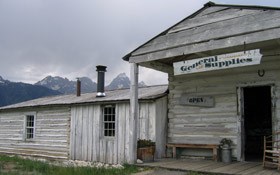
Menor's Ferry and the Chapel of the Transfiguration Location Historical Timeline of Menor's Ferry Menor's Ferry Jackson Hole was isolated by its surrounding mountains and had such a harsh climate that it was one of the last areas of the lower 48 states to be settled. Homesteaders came here, mainly from Idaho, beginning in the late 1880s. Most early settlement in the valley took place in the south, or on a few scattered areas with fertile soil on the east side of the Snake River. Menor was alone on the west side of the Snake for more than ten years. Rivers are often important transportation corridors. However, the Snake River was a natural barrier that divided the valley. In dry months the river could be forded safely in several locations, but during periods of high water even the most reliable fords were impassable. After 1894, Menor’s Ferry became the main crossing in the central part of Jackson Hole. Residents crossed on the ferry to hunt, gather berries and mushrooms, and cut timber at the foot of the mountains. Bill Menor built the original ferryboat and cableworks. Today’s ferry and cableworks are replicas. The ferry is a simple platform set on two pontoons. The cable system across the river keeps the ferry from going downstream, while allowing it to move sideways. By turning the pilot wheel, the rope attaching the boat to the cable is tightened and points the pontoons toward the opposite bank. The pressure of the current against the pontoons pushes the ferryboat across the river in the direction the pontoons point. This type of ferry existed in ancient times and was used elsewhere in the United States. Menor charged 50c for a wagon and team and 25c for a rider and horse. Pedestrians rode free if a wagon was crossing. When the water was too low for the ferry, Menor suspended a platform from the cable and three to four passengers could ride a primitive cablecar across the river. In later years, Menor and his neighbors built a bridge for winter use, dismantling it each spring. Menor sold out to Maude Noble in 1918. She doubled the fares, hoping to earn a living from the growing number of tourists in the valley. Noble charged $1 for automobiles with local license plates, or $2 for out-of-state plates. In 1927, a steel truss bridge was built just south of the ferry, making it obsolete. Maude Noble sold the property to the Snake River Land Company in 1929. Bill Menor and his neighbors homesteaded here thinking of the local natural resources as commodities for survival, but many of them grew to treasure the beauty and uniqueness of Jackson Hole. In 35 short years, from Bill Menor’s arrival until the establishment of the original park in 1929, this land passed from homestead to national treasure. |
Last updated: July 20, 2019
